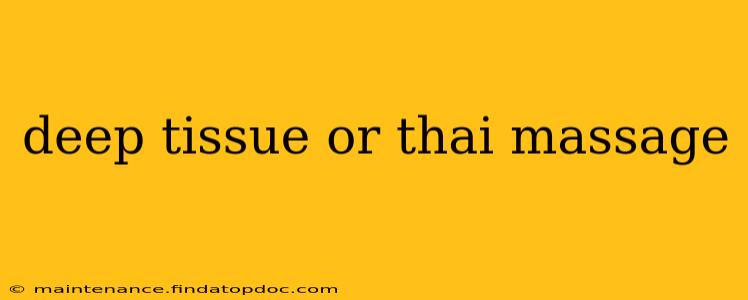Choosing between a deep tissue massage and a Thai massage can be tricky. Both offer profound relaxation and therapeutic benefits, but they differ significantly in their techniques and what they address. This guide will delve into the nuances of each, helping you decide which massage style best suits your needs.
What is Deep Tissue Massage?
Deep tissue massage targets the deeper layers of muscle and connective tissue. It uses slow, firm strokes and deep pressure to release chronic muscle tension and pain. This technique is particularly beneficial for individuals experiencing:
- Chronic pain: Conditions like fibromyalgia, back pain, and arthritis often benefit from deep tissue massage's ability to alleviate persistent muscle tightness.
- Muscle injuries: Deep tissue massage can aid in recovery from strains, sprains, and other muscle injuries by promoting healing and reducing inflammation.
- Post-surgical rehabilitation: In conjunction with other therapies, deep tissue massage can help improve range of motion and reduce scar tissue formation after surgery.
What is Thai Massage?
Thai massage, also known as Thai yoga massage, is a unique bodywork practice that combines elements of acupressure, assisted stretching, and passive yoga. Instead of focusing solely on muscles, it works on energy lines (Sen lines) throughout the body. A practitioner uses their hands, elbows, knees, and feet to apply pressure and move your body through a series of stretches and compressions. Thai massage is ideal for:
- Improved flexibility: The stretches involved in Thai massage can significantly improve your range of motion and flexibility.
- Stress reduction: The rhythmic movements and gentle pressure can promote deep relaxation and reduce stress and anxiety.
- Increased energy: Many find that Thai massage leaves them feeling energized and revitalized, unlike the sometimes-intense relaxation of deep tissue.
Deep Tissue Massage vs. Thai Massage: Key Differences
| Feature | Deep Tissue Massage | Thai Massage |
|---|---|---|
| Pressure | Deep, firm pressure focused on specific areas | Varying pressure, often lighter than deep tissue |
| Technique | Slow, deliberate strokes and kneading | Stretching, compression, acupressure, and passive yoga positions |
| Goal | Release chronic muscle tension and pain | Improve flexibility, energy flow, and stress reduction |
| Clothing | Typically performed with the client lying on a table, clothed or partially clothed | Typically performed with the client clothed in loose clothing |
| Duration | Usually 60-90 minutes | Usually 90-120 minutes |
What are the Benefits of Deep Tissue Massage?
Deep tissue massage offers a multitude of benefits, primarily focusing on pain relief and improved mobility. It's an excellent choice for those with chronic muscle pain or injuries. The deep pressure helps to break up scar tissue and improve circulation, promoting faster healing and reduced inflammation.
What are the Benefits of Thai Massage?
The benefits of Thai massage extend beyond muscle relaxation. It improves flexibility, enhances energy flow, and reduces stress and anxiety. The stretches incorporated in the massage can help to lengthen muscles and improve posture. Many practitioners believe that Thai massage helps to balance the body’s energy system, leading to a sense of overall well-being.
Which Massage is Right for Me?
The best massage for you depends on your individual needs and preferences. Consider the following:
- Your pain level: If you are experiencing severe, chronic pain, deep tissue massage might be more suitable. For milder discomfort or stress relief, Thai massage might be a better option.
- Your flexibility: If you have limited flexibility, Thai massage can be incredibly beneficial for improving range of motion.
- Your personal preference: Some people prefer the targeted, deep pressure of deep tissue massage, while others enjoy the flowing movements and stretches of Thai massage.
Ultimately, the best way to decide is to try both! Many massage therapists offer introductory sessions of varying lengths or styles, allowing you to experience the differences firsthand. Consult with a qualified therapist to discuss your specific needs and determine the most appropriate massage modality for you.
